NGC 2669 is an intermediate age cluster approximately 8600 light years away from Earth in the Southern constellation, Vela. Vela means “sails” in Latin and was given this name due to formerly being part of the constellation Argo Navis, or “The Ship Argo”. Its position in the upper section of Argo is representative of sails on a literal ship and was subsequently named after the subdivision of Argo. The other two constellations in Argo, Carina and Puppis, are also appropriately named after the keel and poop deck of a ship respectively.
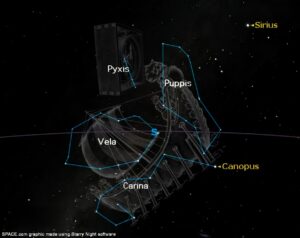
NGC 2669 was first discovered by English mathematician and astronomer John Frederick William Herschel in 1834 at the Cape of Good Hope off the coast of South Africa. However, it was initially recorded by the Persian astronomer Abd al-Rahman al-Soufi in the year 954. This cluster is not observable from here in Saskatoon due to the fact that it lies so far south and never rises above the horizon.
The cluster was studied by Richard Ford (2012) in South Africa. He made observations about variations in star brightness and their distribution within the cluster. One observation he made was the fact that the stars generally tend to get brighter the closer they are to the center of the cluster. I was able to make this distinction myself from my own observations of NGC 2669 using the Skynet Robotic Telescope Network. It is evident in my images that the fainter stars lie on the edge of the cluster and the cluster looks brighter as you approach the center.
I chose to study this specific cluster as part of my FYRE (First Year Research Experience) project in my Astronomy 113 course. The process of studying NGC 2669 included using the services and software Afterglow, the Skynet Robotic Telescope Network, and Clustermancer Astromancer. This allowed me to investigate the relationships between characteristics such as brightness, colour, age, and chemical composition. The study started with capturing 20 images of the cluster, 5 for each B, V, R, and I filter. Since this cluster is only visible by prompt telescopes in the southern hemisphere, I was limited to only using Prompt-5 in Cerro Tololo, Chile and Prompt-MO-1 in Meckering, Australia, however, all the images were taken with Prompt-MO-1. The exposure lengths used for each filter are as follows: B – 30 seconds, V – 20 seconds, R – 10 seconds, I – 10 seconds. The images were stacked according to their filters and then grouped to create an apparent colour image of the cluster. To de-redden the image, Clustermancer was used to remove field stars from my cluster and add more data for the cluster from Gaia and 2MASS. I was able to create an Isochrone model fit to several HR diagrams for my cluster and obtain these results:
| Proper Motion RA (mas/yr) | Proper Motion Dec (mas/yr) | Distance (kpc) | Log (Age(yrs)) | Metallicity (solar) | E(B-V) |
| -3.93 | 4.5 | 1.01 | 8.25 | -0.5 | 0.3 |
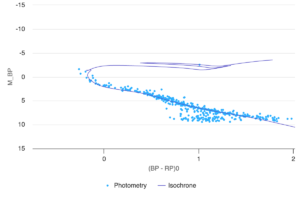
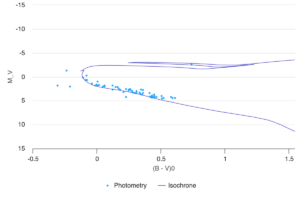
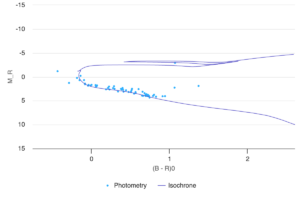

Using the E(B-V) value obtained from Clustermancer, I created a de-reddened image of my cluster in Afterglow.
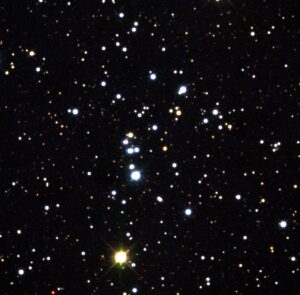
With my analysis of NGC 2669, I discovered that it is a fairly small open cluster with approximately 50 stars. This small size made the job of removing field stars in Clustermancer and creating a properly fitted isochrone model not as tedious. It consists largely of blue massive stars and also includes a red giant. Overall this cluster isn’t greatly spectacular, however, most of the fun in doing this work comes from the background research and understanding the relationship between the data.
Using the Milky Way Stars Catalog, I fetched the accurate Gaia data for the cluster and replotted the isochrone models and HR diagrams. The data was only slightly different from my own which resulted in a diagram that was very minimally different from mine. Even so, the Gaia data seems to be more accurate due to the isochrone model having a slightly better fit on the HR diagram.

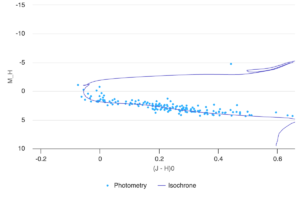
Having completed my analysis, I gained a higher appreciation for the people who devote their lives to this work on a much larger scale. The greatest learning curve for me was initially understanding how to properly remove field stars and create an accurate isochrone model in Clustermancer. After completing this project, I feel fulfilled and happy with the results and gaining new knowledge and tools to study objects far, far away in our galaxy.